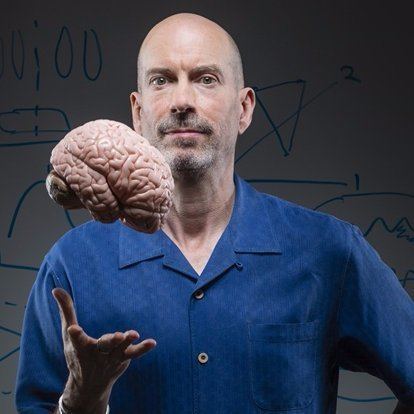Name Earl Miller | Role Professor | |
 | ||
Education | ||
Working Memory 2.0 - Earl K. Miller
Earl Keith Miller (born November 30, 1962, Columbus OH) is a systems/cognitive neuroscientist, whose research focuses on neural mechanisms of learning, memory, and cognition. Earl Miller is the Picower Professor of Neuroscience with the Picower Institute for Learning and Memory and the Department of Brain and Cognitive Sciences at Massachusetts Institute of Technology. He is also the Chief Scientific Officer and Co-founder of SplitSage
Contents
Education
Earl Miller received a B.A. (summa cum laude, with honors) in psychology from Kent State University (1985), M.A. in psychology and neuroscience from Princeton University (1987), and a PhD in psychology and neuroscience from Princeton University (1990). From 1990–1995 he was a postdoctoral fellow in the Laboratory of Neuropsychology at the National Institute of Mental Health.
Distinctions
Earl Miller has won a number of awards throughout his career, including the McKnight Scholar Award (1996), Pew Scholar Award (1996) John Merck Scholar Award (1998), the Society for Neuroscience Young Investigator Award (2000) National Academy of Sciences' Troland Research Award (2000), he was tenured at MIT two years ahead of schedule (1999), Fellow of the American Association for the Advancement of Science (2005), the Mathilde Solowey Award in Neurosciences (2007),, a MERIT Award from the National Institute of Mental Health (2010), an Amar G. Bose Research Fellowship (2014), the Kent State University Professional Achievement Award., the Goldman-Rakic Prize for Outstanding Achievement in Cognitive Neuroscience (2016), Paul and Lilah Newton Brain Science Award (2017), and election to the American Academy of Arts and Sciences (2017), one of the nation’s most prestigious honorary societies. He delivered the Commencement Address at Kent State University in 2016.
Earl Miller's paper with Jonathan Cohen, “An Integrative Theory of Prefrontal Cortex Function", has been designated a Current Classic as among the most cited papers in Neuroscience and Behavior.. As of July 2017, Miller and Cohen (2001) is the 5th most-cited paper in Neuroscience. His paper with Tim Buschman, "Top-down versus Bottom-up Control of Attention in the Prefrontal and Posterior Parietal Cortices" was The Scientist's Hot Paper for October 2009
Professional
In 1995 Earl Miller joined the faculty of the Department of Brain and Cognitive Sciences at MIT as Assistant Professor of Neuroscience and quickly advanced the academic ranks. He received tenure in 1999 (ahead of schedule) and became Professor in 2002. He was appointed to the Picower chair at MIT in 2003. He was Associate Director of the Picower Institute for Learning and Memory at MIT from 2001 to 2009, and was Director of Graduate Studies in Brain and Cognitive Sciences at MIT. He has delivered numerous lectures worldwide, serves as editor, and on the editorial boards of, major journals in neuroscience, and on international advisory boards. He has served on the advisory boards of NeuroFocus, a Berkeley, California based neuromarketing company. and Motimatic. Professor Miller is the Co-Founder and Chief Scientific Officer of SplitSage.
Research
Earl Miller's research aims to understand how the prefrontal cortex, a neural system located in the frontal lobe of the brain, subserves cognitive control. Cognitive or executive control involves the higher-order processing that comes into play when our behavior has to be guided by plans, thoughts, and goals. This sort of behavior contrasts with the one that is primarily driven by external stimuli or by emotion, as well as with behavior that is stereotypical and automatic. Although the prefrontal cortex (PFC) has long been thought to mediate executive functions in the human brain, the mechanisms through which PFC regulates this goal-oriented, purposeful behavior were not clearly understood.
Research conducted in Earl Miller's laboratory has shown that such cognitive control is manifested in the neural activity in the primate PFC. The activation of PFC neurons can reflect the abstract cognitive process that is guiding behavior during a control-demanding task. PFC neurons, thus, have been documented to represent abstract rules such as "same vs. different", to process the category or quantity of visual stimuli, and to guide the allocation of attentional resources. PFC activity has also been shown to reflect the flexible remapping of stimulus-response associations. These results have arisen through a combination of electrophysiological, psychophysical, and computational techniques.
Miller has innovated techniques for recording from many neurons simultaneously in multiple brain areas. This is a departure from the classic single-neuron recording approach. It allows detailed and direct comparison of neuron properties between brain areas that are not confounded by extraneous factors and examination of the temporal dynamics of activity between neurons. Miller's lab has used this approach to make a number of discoveries of how different brain areas collaborate to produce thought and action. This includes recent discoveries that oscillating "brain waves" may control the timing of shifts of attention and that different items simultaneously held in short-term memory line up on different phases of each brain wave. The latter may explain why we can only think about a few things at the same time.
Media Appearances
Earl Miller has made frequent appearances in the popular press. He was profiled in Discover Magazine and The New Yorker. He wrote a guest column in Fortune. Professor Miller has appeared on NBC's Today Show and has been a frequent guest on National Public Radio and several talk radio shows. He has been quoted and/or his work profiled in the New York Times, CNN, MSNBC, ABC News, Slate, The Boston Globe, The Times of London, etc. A list of his media appearances is available on his website
